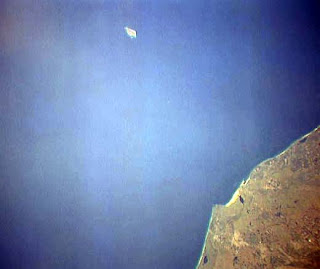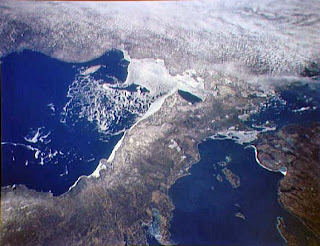Cumulonimbus Cloud over Africa Perhaps the most impressive types of clouds are cumulonimbus. These dynamic clouds form when warm, moist, and unstable air vigorously rises in the atmosphere. If sufficient atmospheric moisture is present, water droplets condense as the air mass encounters cooler air at higher altitudes.
As water in the rising air mass condenses and changes from a gas to a liquid state, it releases energy and further heats the surroundings, which further intensifies the convection process and causes the cloud to rise to an even higher altitude. An example of one of these vertical “tower clouds” is visible in the astronaut photograph included above. If enough moisture is present to condense and heat the cloud mass through several convective cycles, a tower can rise to altitudes of approximately six miles (10 km) at high latitudes and to 12 miles (20 km) in the tropics. The cloud formation process stops its upward convection when it encounters a region of the atmosphere known as the tropopause—the boundary between the troposphere and the stratosphere.
The tropopause is characterized by a strong temperature inversion. Beyond the tropopause, the air no longer gets colder as altitude increases. When the cloud formation reaches this atmospheric layer, the cloud tos flattens and spreads into an anvil shape, as illustrated by this astronaut photograph. The photo was taken from a side angle, rather than looking straight down towards the Earth’s surface. The image was taken over western Africa near the Senegal-Mali border. The image shows a fully formed anvil cloud with numerous smaller cumulonimbus towers rising near it. The high energy levels of these storm systems typically make them hazardous due to associated heavy precipitation, lightning, high wind speed,s and possible tornadoes.
The Colorado Plateau spans northern Arizona, southern Utah, northwestern New Mexico, and southwestern Colorado. This physiographic province is well known for its striking landscapes and broad vistas—an impression that is enhanced by the view from the orbital perspective of the International Space Station. This astronaut photograph highlights several prominent landforms including the Colorado River, dammed to form Lake Powell in 1963, crosses from east to west (which is left to right here because the astronaut was looking south; north is towards the bottom of the image). The confluence of the Colorado and San Juan Rivers is also visible. Sunglint—sunlight reflected off a water surface back towards the observer—provides a silvery, mirror-like sheen to some areas of the water surfaces.
The geologic uplift of the Colorado Plateau led to rapid down cutting of rivers into the flat sedimentary bedrock, leaving spectacular erosional landforms. One such feature, The Rincon, preserves evidence of a former meander bend of the Colorado River.
Snow cover blankets the higher elevations of Navajo Mountain, a large body of igneous rock that intruded into pre-existing sedimentary rock layers and bowed them upwards into a structural dome. Snow also caps the highland surface of the Kaiparowits Plateau (approximately 2,300 meters or 7500 feet in elevation). The bulk of Navajo Mountain and the Kaiparowits Plateau are within the state of Utah; the town of Page is located just south of the border in Arizona.
Himalayan Landscape The above photograph of Bhutan, taken by one of the Expedition 33 crew members aboard the International Space Station, shows a number of Himalayan peaks, glaciers and lakes.
Michigan, U.P., and Grand Marais Photos When you go to the NASA website I list at the top of this posting, you can type in any location on earth into the search box. The chances are that there is a photo in the archive. There were many dozen pictures listed for Grand Marais. Below I've included a few. Look for the Grand Sable Dunes and Sable Lake. The pictures were taken from different angles -- so for you GM faithfuls, have fun examining the perspectives.
Himalayan Landscape The above photograph of Bhutan, taken by one of the Expedition 33 crew members aboard the International Space Station, shows a number of Himalayan peaks, glaciers and lakes.
Michigan, U.P., and Grand Marais Photos When you go to the NASA website I list at the top of this posting, you can type in any location on earth into the search box. The chances are that there is a photo in the archive. There were many dozen pictures listed for Grand Marais. Below I've included a few. Look for the Grand Sable Dunes and Sable Lake. The pictures were taken from different angles -- so for you GM faithfuls, have fun examining the perspectives.
In the above photo notice Caribou Island out in the middle of Lake Superior. The island is located approximately 40 miles north of Grand Marais.
The color in the upper left corner of the above photos shows the sun's glint off the northern end of Lake Michigan. The remainder of the photos below are of the Great Lakes. A few show the Grand Marais area. Some of the following photos show ice flows on the Great Lakes.





















































